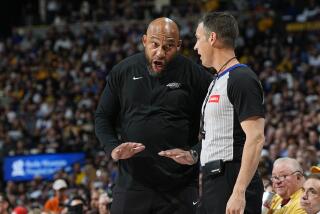Baseball will take new look at replays
A 144-year-old sport that popularized the phrase “kill the ump” now has a 21st century idea: Correct the ump.
In a radical step for a sport steeped in tradition, Major League Baseball announced Thursday its intention to make instant replay available on almost all calls made by umpires, starting next year, pending the expected approval of owners, players and umpires.
“This is a historic day,” Commissioner Bud Selig said at the owners’ meetings in Cooperstown, N.Y.
Selig long had resisted any use of replay, citing the charm of the human element and the concern over whether lengthy video reviews might stall games. In 2008, baseball became the last of the four major North American sports leagues to introduce replay reviews but limited it to calls involving home runs.
After a series of high-profile embarrassments since then -- most notably when umpire Jim Joyce cost Detroit Tigers pitcher Armando Galarraga a perfect game by blowing a ninth-inning call at first base in 2010 -- calls to expand the replay system had grown louder.
“The biggest thing is that everybody watching the game knows at home, because they have replay,” Angels pitcher C.J. Wilson said.
The NBA, NFL and NHL all use replay in significant ways -- including verifying goals in hockey and checking whether a buzzer-beating shot actually beat the buzzer in basketball -- but baseball is the only major sport that requires its official to make a call on every play. Officials in other sports can just allow play to continue without blowing a whistle or dropping a flag.
The system outlined Thursday would allow managers to challenge three calls during a game, and to contest virtually anything except calls of balls and strikes. If the call is overturned, the manager is not deducted a challenge.
John Schuerholz, president of the Atlanta Braves, served on the committee that designed the new system and said 89% of incorrect calls in recent years now would be subject to review. The committee determined one play in every five games would be affected.
Schuerholz said challenges would be reviewed in a video war room at league offices in New York, not by umpires at the game.
He also said managers would be ejected if they argued a call subject to review, which could eliminate the entertaining but lengthy nose-to-nose yelling matches between umpires and managers. Schuerholz estimated the average video review would take one minute 15 seconds.
Tom Lasorda, the Dodgers’ Hall of Fame manager, said he was not sure the reviews could be completed so quickly. He said he was concerned multiple reviews could add to the length of games and said umpires should not be subject to review for calls at the bases.
“They’ll actually be slowing down the game,” Lasorda said. “You put the umpires under a lot of stress.
“Everybody is going to miss plays. It’s not intentional. Now you put these guys under the gun.”
Said Wilson: “Games are long anyway, so if they take an extra two minutes because of that, so be it. I think people would rather have the result of the game, which is set in stone after it’s finished, be right.”
Angels first baseman Mark Trumbo said the NFL has shown replays can be done efficiently and said players can “rest a little easier” about a disputed call.
“At the end of the day, you’re 99% sure that’s the right call,” Trumbo said. “Arguments might be fun for the fans, but you’d rather go without them.”
Washington Nationals Manager Davey Johnson said the expanded replay might not go far enough. Johnson told reporters in Washington that the league ought to consider an “electronic strike zone” to monitor calls of balls and strikes.
Major league owners are set to approve the expanded replay system in November, and its adoption is contingent on the expected approval of the unions representing players and umpires.
The league did not explain how a manager would inform umpires of his intention to challenge a call. In the NFL, coaches throw a flag onto the field. Bruce Bochy, the manager of the World Series champion San Francisco Giants, joked that he might have to be ready to do that over a 162-game baseball season rather than a 16-game football season.
“I’ve got to get my arm back in shape if that’s the case,” Bochy told reporters covering the Giants.
--
Twitter: @BillShaikin
Times staff writer Mike DiGiovanna contributed to this report from New York. Shaikin reported from Los Angeles.
--
(BEGIN TEXT OF INFOBOX)
How replay is used
Examples of how other pro sports use replay:
NBA
Officials can use replay to see if a shot was released before time expired. Replay also determines which players should be ejected after a brawl or flagrant fouls. Replay can determine if a shot is worth two or three points, or to decide possession on balls that go out of bounds. It may also be used if the game clock malfunctions to determine the correct amount of time left. Beginning this season, it can be used to review a block/charge play to see if the defender was inside or outside the restricted area. Also this season, it can determine if an off-ball foul occurred before or after the ball is released.
NHL
The video goal judge reviews replays of disputed goals. Examples include if the puck crosses the goal line completely before time expired or if a puck is in the net before it is dislodged. Replay can also be used to determine if a puck is directed into the net by a hand or foot or if it is deflected into the goal by an official or high stick.
NFL
Each coach is allowed two challenges on certain reviewable calls as long as it is not in the last two minutes in a half and the team has one timeout left. If the challenge fails, the team loses a timeout. Calls that can be reviewed include scoring plays, pass completions, if a player is out of bounds, quarterback pass or fumble and if a player is down by contact. It can also be used to determine forward progress and number of players on the field.
Tennis
In tennis, computer systems process the input of several video cameras to determine if a ball is in or out. Players can make up to three unsuccessful challenges per set, and a fourth in a tiebreak. Television broadcasts may use the footage to replay points even when not challenged by a player.
More to Read
Go beyond the scoreboard
Get the latest on L.A.'s teams in the daily Sports Report newsletter.
You may occasionally receive promotional content from the Los Angeles Times.







